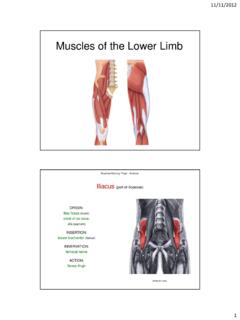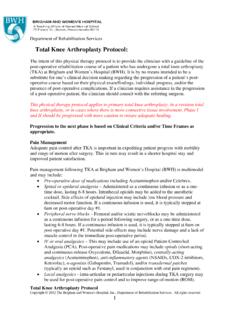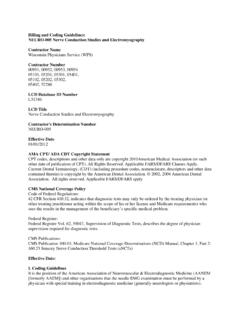Transcription of MRI of the Lumbosacral Plexus - Skeletal Rad
1 MRI of the Lumbosacral PlexusDEPARTMENT OF RADIOLOGY AND IMAGING SCIENCESWhat the Practicing Radiologist Needs to KnowHailey Allen, MDMegan K. Mills, MD Miriam Peckham, MDLubdha Shah, MDRichard K. Sanders, MDSarah E. Stilwill, MD NOTHING TO DISCLOSE Be familiar with normal Lumbosacral Plexus anatomy, in addition to transitional Lumbosacral nerve anatomy Understand the key MRI sequences utilized to adequately image patients with suspected Lumbosacral nerve pathology Recognize both the normal and abnormal MRI appearance of peripheral nerves Have a robust and practical differential diagnosis for abnormalities associated with the Lumbosacral Plexus on MRIA fter review of this exhibit, the learner will.
2 LEARNING OBJECTIVES Discuss role of MR imaging of the Lumbosacral Plexus in clinical practice Review Lumbosacral Plexus normal anatomy and important normal variant anatomy Discuss key MRI sequences and present an MRI sequence based search pattern Review the MRI appearance of normal and abnormal peripheral nerves OUTLINE Case based imaging review of the following topics: Neuropathy Tumor and Tumor Like Conditions Infectious and Inflammatory Pathology Trauma Increased accuracy for diagnosis of the exact location, type, extent and cause of peripheral neuropathy / plexopathy Excellent distinction of traumatic and atraumatic Lumbosacral Plexus pathology from spine related abnormalities, which can be a clinical conundrum Provides fine detail anatomic information given high spatial and contrast resolution for pre surgical planningROLE OF Lumbosacral Plexus MRICor STIR MIP In 2017, the American College of Radiology released guidelines regarding the clinical use of Lumbosacral Plexus MRI ACR APPROPRIATENESS CRITERIA.
3 PLEXOPATHY The panel consensus gives its highest rating to contrast enhanced MRI of the Plexus for patients with suspected acute or chronic plexopathy with or without a history of trauma or in the setting of malignancy or prior radiation In patients who cannot undergo MRI, alternative imaging modalities such as CT or FDG PET/CT can be consideredApproach to Normal Anatomy Lumbosacral Plexus : Formed by the coalescence of the ventral rami of the lumbar Plexus (T12, L1 L4) and the sacral Plexus (L4 S4) to form the Lumbosacral (LS) trunk Sag T2 FSAx T2 FSL3L4Ax T2 FSL4 FNL5 ONAx T2 FSAt the L4 levelL4 FNL5 ONAt the proximal sacrum At the L5 level (a) The extra foraminal L3 segment is seen diving deep into the psoas major muscle (b) The obturator nerve (ON, L2 L4 nerve roots) runs medial to the psoas.
4 The L4 femoral nerve component (FN) lies more posterior and lateral within / along the psoas major muscle (c) The L5 nerve hugs the sacral promontory and then combines with the peroneal component of the L4 nerve to form the Lumbosacral trunk . The LS trunk joins S1 S3 just proximal to the sciatic notch > forming the sciatic nerveAx T2 FSabcApproach to Normal Anatomy The obturator nerveis formed by the L2 L4 nerve roots and seen coursing along the medial border of the psoas major muscle (see previous slide) deep to the common iliac vessels, and lateral to the sacrum. It has a straight course, extending along the lateral pelvic side wall (a) to enter the obturator foramen (b).
5 It pierces the fascia between the pectineus(p) and adductor brevis (ab) muscles (c) where it splits into anterior and posterior divisons The femoral nerveis formed by the L2 L4 nerve roots and extends inferiorly between the psoas major and iliacus muscles (see previous slide), emerging beneath the inguinal ligament (a) and into the thigh, where it splits into anterior and posterior divisions (b,c) The sciatic nerve is formed by the coalescence of L4 S3 nerve roots. It courses anterior to the piriformismuscle (a), then posterior to it extending from the pelvis through the greater sciatic notch, deep to the gluteus maximus muscle, and into the posterior compartment of the thigh (b,c) The sciatic nerve is formed by the coalescence of L4 S3 nerve roots.
6 It courses anterior to the piriformismuscle (a), then posterior to it extending from the pelvis through the greater sciatic notch, deep to the gluteus maximus muscle, and into the posterior compartment of the thigh (b,c)Ax T1 *At the level of the sciatic notchAx T1 *At the level of the ischial tuberositiesAx T1 *At the level of the obturator foramenacbpabMuscle Innervation Patterns Obturator nerve > motor innervation includes external obturator, adductor compartment muscles, gracilis, and pectineusAx T1 femoral nerve > motor innervation of quadriceps, pectineus, proximal anterior thigh muscles including sartoriusAx T1 Sciatic nerve > provides motor innervation of the anterior and lateral compartments of the lower leg via the peroneal nerve (mostly L5) and provides motor innervation of the hamstring muscles via the tibial component (mostly S1)
7 Ax T1 FemurAx T1 Prox lower legApproach to Normal AnatomyIdentification of L5 Nerve: Neuroanatomic Method After exiting the neural foramen, L4 splits into peroneal and tibial branches (orange solid and dashed arrows, respectively) L5 is the only lumbar nerve which does not branch (blue arrows) The peroneal branch (solidorange arrow) of L4 typically joins the L5 nerve (blue arrows) root at the level of the sacrum The L5 nerve root is typically twice the size of the L4 peroneal branch*Images and graphics modified with the authors permission. Peckham AJNR Am J Neuroradiol 2017. % of Population#of Presacral Vertebral Bodies # of LumbarType Vertebral Bodies 89245825 6323 4 Lumbosacral Transitional Vertebrae: Defined by variable elongation of the transverse process of the last lumbar vertebrae to fuse, in whole or in part, with the sacrum (blue arrows) 5% of the population has both transitional vertebrae and a variant number (6 or 4) of lumbar type vertebral bodies Sacralization of L5 results in a rudimentary L5 S1 disk (asterisk) The iliolumbar ligament (pink arrows) typically arises from the L5 transverse process and inserts onto the iliac crest This method accurately identifies the L5 vertebra in 83% of cases Identification of L5.
8 The Iliolumbar Ligament Method*L5S1L4L3L2L1 Approach to Transitional AnatomyVertebral Numeric Variation At the level of the sacrum : In patients with 4 lumbar type vertebrae, L4 splits into peroneal and tibial branches (solid and dashed orange arrows) In patients with 6 lumbar type vertebrae, two large nerves of similar caliber are present, representing L5 (blue arrow) and S1 (yellow arrow)4 Lumbar type Vertebrae5 Lumbar Vertebrae6 Lumbar type VertebraeL4L4L5L5S1 Approach to Transitional AnatomyIdentification of L5 Nerve: Neuroanatomic Method Coronal T1 Coronal STIRA xial T1 Axial T2 FSSagittal PD FSOblique Coronal T1 Oblique Coronal T2 FS Imaging at field strength results in images with higher signal to noise Patients with surgical hardware in the lower back or pelvis are imaged at field strength to minimize susceptibility artifact Field of view includes from L3 level extending though the proximal thigh.
9 Axial slice thickness = 5 mm2D or 3D Coronal STIR SPACEMRI Protocol Overview Coronal T1 FS + ContrastAxial T1 FS + ContrastWell suited for assessment of: Perineural and intermuscular fat Chronic fatty muscle infiltration Met Hgb blood products Marrow signal(a,b) Images from a normal Lumbosacral Plexus MRI demonstrate symmetric muscle bulk with no significant fatty infiltration (asterisks). The visualized proximal coursing lumbar and sacral nerves (arrows) are surrounded by homogeneous fat signal. (c) Marked disproportionate fatty atrophy of the right gluteus maximus muscle (chevron)(a,b) Images from a normal Lumbosacral Plexus MRI demonstrate symmetric muscle bulk with no significant fatty infiltration (asterisks).
10 The visualized proximal coursing lumbar and sacral nerves (arrows) are surrounded by homogeneous fat signal. (c) Marked disproportionate fatty atrophy of the right gluteus maximus muscle (chevron)Cor T1 Oblique Cor T1Ax T1a b c ** Coronal oblique images are acquired in a plane coronal to the sacrumMRI Protocol and Search Pattern T1 Sequence: Key Facts Well suited for assessment of: Nerve caliber and signal intensity Perineural and fascicular edema Muscular edema; isolated to muscles downstream to the injured nerve MRI Protocol and Search Pattern Fluid Sensitive Sequences ( T2 FS / STIR / SPAIR): Key Facts *a *b (a) Image from a normal Lumbosacral Plexus MRI demonstrates symmetric caliber of the exiting sacral nerves.






